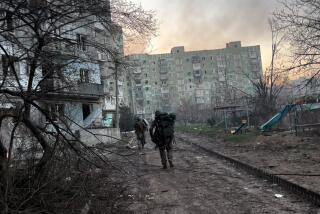Urban Warfare Demands Patience
As coalition forces tighten the grip around Baghdad, horror stories about house-to-house combat and American troops’ preparedness to fight an urban war are already being told.
Certainly, the nature of the urban environment exacerbates the inherent danger and friction that are the essence of combat. Large cities combine various forms of structures, terrain and road networks into a chaotic environment. Modern cities also have a subterranean dimension, with subways, sewers and other underground facilities.
Baghdad, as with most cities that have emerged from antiquity, is part modern, characterized by broad, straight streets and high-rise buildings, and part ancient -- narrow twisted alleys and buildings built on top of one another.
Movement by forces in open areas -- streets, alleys, parks -- is the most dangerous facet of urban combat. Seventy percent of the casualties occur in these open areas, where the defender has his best fields of fire and where invading forces are most exposed.
The dense concrete and steel structures of a modern city, coupled with the presence of millions of innocent civilians, can negate some aspects of the overwhelming conventional military superiority of the United States. However, with the right approach, the battle for Baghdad need not look like the Russian army in the first battle for Grozny.
Although it is not a strong characteristic of our national culture, patience is a virtue, and even more so at this particular point in Operation Iraqi Freedom. In both strategic and operational terms, we need to adjust our perspective on speed and momentum now that we are approaching Baghdad.
Strategically, we must now shift gears from overwhelming the Iraqi forces with the sheer velocity of our military might and work to isolate Baghdad.
This next phase of our campaign is likely to take longer than the initial blitzkrieg.
Operationally, we need to develop a detailed picture of the situation inside Baghdad and identify the resistance levels around key government facilities and military strong points.
Speed and momentum have been force multipliers up to this point, but now we need to “control the clock” and demonstrate our ability to control events at a time and opportunity of our choosing.
To build a complete picture of the situation inside Baghdad, our forces will need to conduct patrols through the city, engaging the enemy where he is found. But more important, our patrols must make contact with average Iraqi citizens, the ones who have been oppressed by the Hussein regime.
Just as the British are now doing in Basra, we must give the people of Iraq a sense of our commitment to their security and enlist their aid in identifying and locating the enemy in their midst.
We must do this in a clandestine fashion that does not put the innocent civilians at risk.
The military calls this “boots on the ground,” the old-fashioned low-tech warfare in which our infantrymen slowly and methodically develop a picture of the battle space.
Large urban areas like Baghdad -- roughly the size of Los Angeles proper -- are extremely complex pieces of terrain. The density of the population, buildings, transportation networks and power centers will complicate our ability to develop a very detailed understanding of the operational and tactical situation inside the Iraqi capital.
Such a detailed understanding requires intelligence from many forms, including Iraqi civilians, special operations forces inside the city, electronic intelligence, unmanned vehicles and overhead imagery.
Without this information, we will face an inordinate risk in penetrating the city to eliminate Saddam Hussein’s strongholds or in reaching Iraqi civilians who are in need of assistance. The British forces, the U.S. Army and the Marines are fully aware of the difficulties inherent to urban fighting.
In Basra, British forces are asking the Iraqi populace to help identify Fedayeen so they can target them.
The U.S. soldiers and Marines in Iraq can employ the same tactics to conduct this intelligence gathering and then, very deliberately, conduct a successful takedown of the remaining elements of the Iraqi regime.
This need not be a rerun of “Black Hawk Down.” Be patient and give our forces the time they need to end Hussein’s reign of terror.
More to Read
Sign up for Essential California
The most important California stories and recommendations in your inbox every morning.
You may occasionally receive promotional content from the Los Angeles Times.










